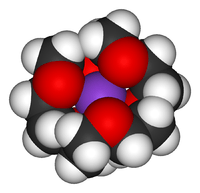Charles J. Pedersen
| Charles John Pedersen | |
|---|---|
 | |
| Born |
October 3, 1904 Busan, Korean Empire |
| Died |
October 26, 1989 (aged 85) Salem, New Jersey, USA |
| Nationality | American |
| Alma mater | University of Dayton, Massachusetts Institute of Technology |
| Awards | Nobel Prize in Chemistry (1987) |
| Scientific career | |
| Fields | Organic chemistry |
| Institutions | DuPont |

Charles John Pedersen (October 3, 1904 – October 26, 1989) was an American organic chemist best known for describing methods of synthesizing crown ethers. He shared the Nobel Prize in Chemistry in 1987 with Donald J. Cram and Jean-Marie Lehn. His Japanese first name was Yoshio (良男).[1] He is the only Nobel Prize laureate born in Korea other than Peace Prize laureate Kim Dae-jung.[2]
Biography
Pedersen was born in Busan, on the coast of south-eastern Korea, to a Norwegian father Brede Pedersen and a Japanese mother Takino Yasui, in 1904.[3] Due to his father's work as an engineer, he spent part of his childhood near the Unsan mine in present-day North Korea.[4] He moved to Japan with his family at the age of eight years to attend a convent school in Nagasaki. When he was ten years old, he moved to Yokohama and entered an international school, called Saint Joseph College. He came to the United States in 1922 to study chemical engineering at the University of Dayton in Ohio. After receiving a bachelor's degree, he went to the Massachusetts Institute of Technology where he received a master's degree in organic chemistry. Although his professors encouraged him to pursue a Ph.D. at MIT, Pedersen decided to start his career instead, partially because he no longer wanted to be supported by his father. He is one of the few people to win a Nobel Prize in the sciences without having a Ph.D.[1]
In 1927, Pedersen began working for DuPont where he would remain for the next 42 years, retiring at the age of 65. At DuPont, his work resulted in 25 papers and 65 patents. In 1967 he published two works that are now considered classics;[5] they describe the methods of synthesizing crown ethers (cyclic polyethers).[6] The donut-shaped molecules were the first in a series of extraordinary compounds that form stable structures with alkali metal ions. In 1987 he shared the Nobel Prize in Chemistry with Donald Cram and Jean-Marie Lehn for his work in this area; Cram and Lehn expanded upon his original discoveries.
Pedersen was diagnosed with myeloma in 1983, and though he was becoming increasingly frail, he traveled to Stockholm to accept the Nobel Prize in late 1987. Shortly thereafter, he was awarded a medal for excellence by the du Pont Research Fellows. He died on 26 October 1989 in Salem, New Jersey.[7]
See also
References
- 1 2 "Charles J. Pedersen - Biographical". The Nobel Foundation.
- ↑ "DJ와 또 한 명 … 노벨위원회엔 '한국 출생 수상자' 2명 기록 [DJ and another ... Nobel committee's record of two Korean-born winners]". Joins.com. October 12, 2014.
- ↑ The Journal of the American Chamber of Commerce in Japan. ACCJ. 1987. p. 41.
- ↑ Wong, Sue-Lin; Sagolj, Damir (April 12, 2018). "The Cold Frontier: Dreams of Gold". Reuters. Retrieved April 12, 2018.
- ↑ C. J. Pedersen (1967). "Cyclic polyethers and their complexes with metal salts". Journal of the American Chemical Society. 89 (26): 7017–7036. doi:10.1021/ja01002a035.
- ↑ Charles J. Pedersen (1988). "Macrocyclic Polyethers:Dibenzo-18-Crown-6 Polyether and Dicyclohexyl-18-Crown-6 Polyether". Organic Syntheses. ; Collective Volume, 6, p. 395
- ↑ "The Benner, Cleaveland and Related Families - Obituary of Charles Pedersen". rgcle.com. Archived from the original on February 8, 2011. Retrieved November 7, 2010.
External links
| Wikiquote has quotations related to: Charles J. Pedersen |


